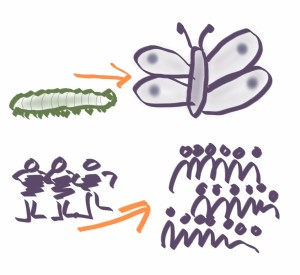For the purposes of this post, the term ‘transition point’ means any point where something changes from one state to another. Some examples are;
- A caterpillar changing to a butterfly
- A company growing from a start-up to a large business
- Developing a skill from basic to competent and then to expert would be considered at least 2 transition points
 We assume that it is easy to anticipate when transition points are going to happen – this is because for our whole lives up to now we are looking into the past and it is easy to see when transitions occurred. But this is a fallacy – we are using the benefit of hindsight to observe when the transition happened and in many cases we could not have estimated when the transition would occur beforehand.
We assume that it is easy to anticipate when transition points are going to happen – this is because for our whole lives up to now we are looking into the past and it is easy to see when transitions occurred. But this is a fallacy – we are using the benefit of hindsight to observe when the transition happened and in many cases we could not have estimated when the transition would occur beforehand.
Transition points can impact efficiency – I harvested some damson plums this morning and was pushing out the stones with a cherry pitter. Easy for 10-20 plums – but I was doing over 100 of them. The transition in this case was the scale of fruit that I was preparing – I found that I was picking up the cherry pitter, then putting it on the other side of the sink, then picking up a strawberry huller to get the stone out. I found that putting down the cherry pitter on the same side of the sink that I was working on instead of the opposite side sped up the process.
The same thing happens at work – imagine a small company dealing with incoming traditional mail – almost anyone can manage it on top of their normal job because only a small amount would get delivered each day. But it is easy to see a difference in a large company – often there are several people who have full-time jobs sorting and delivering the traditional mail and parcels. When did the transition point/s occur? How did they get detected and then managed?
When we notice problems, these can be symptoms of a transition point in progress – I noticed the delay caused by reaching to the other side of the sink and created a counter-measure to reduce the distance to put down and pick up the tool. But imagine that someone delivered a lot more plums to me – how would I process them in that case? The 100 or so this morning took me about 30 minutes to pit. The process I used today would be very inefficient in a plum jam factory – how many other things are we doing in ways that we always have and imagine them to be efficient? Perhaps an external factor has changed that we have not noticed yet and our ways of working have therefore reduced in efficiency.
The term ‘counter-measure’ in the Lean sense is starting to grow on me. It is a good term to use instead of ‘fix’ because any action that we take to address a problem is likely to become less useful later on and we will need to create and implement a new counter-measure at that time. It takes the pressure away from finding the perfect solution and focussing instead on one that is good enough to address the issue that we are observing, implement it and then observe the effect of the counter-measure – adjusting again when needed.
In Summary
- Efficiency can drop if we apply the same ways of working when a transition point occurs
- It is easy to see the transition points afterwards, but hard to anticipate them – use problems and issues as indicators of transition points
- Using the term ‘counter-measure’ instead of ‘fix’ can be helpful to recognise that future transition points will happen and a new counter-measure will need to be developed later
Of course, this post has been using the term ‘efficiency’ which is not the same as ‘effectiveness’. We also need to be aware that the effort we are making is towards a valuable outcome. In the case of my plums, I am just about ready to put the cooked plum paste into a container – this is valuable for me, but not for people who do not enjoy the taste of plums. For such people, it might have been just as good for me to put the plums into a compost bin – but then I would not have had to remove the stones – so being more efficient with that process would have been wasted efficiency.
